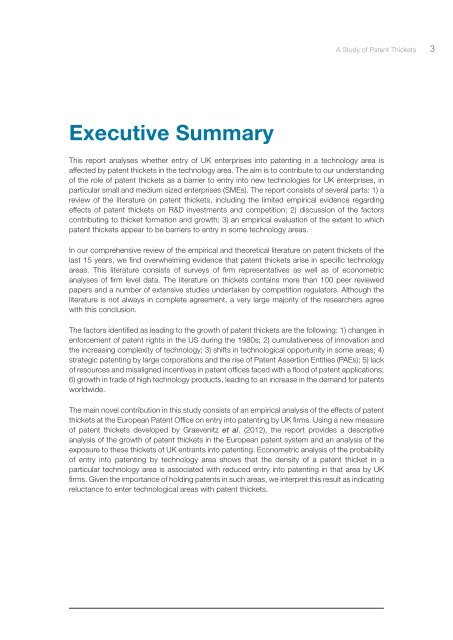A study of Patent Thickets (1.31Mb) - UK Intellectual Property Office
A study of Patent Thickets (1.31Mb) - UK Intellectual Property Office
A study of Patent Thickets (1.31Mb) - UK Intellectual Property Office
Create successful ePaper yourself
Turn your PDF publications into a flip-book with our unique Google optimized e-Paper software.
A Study <strong>of</strong> <strong>Patent</strong> <strong>Thickets</strong> 3<br />
Executive Summary<br />
This report analyses whether entry <strong>of</strong> <strong>UK</strong> enterprises into patenting in a technology area is<br />
affected by patent thickets in the technology area. The aim is to contribute to our understanding<br />
<strong>of</strong> the role <strong>of</strong> patent thickets as a barrier to entry into new technologies for <strong>UK</strong> enterprises, in<br />
particular small and medium sized enterprises (SMEs). The report consists <strong>of</strong> several parts: 1) a<br />
review <strong>of</strong> the literature on patent thickets, including the limited empirical evidence regarding<br />
effects <strong>of</strong> patent thickets on R&D investments and competition; 2) discussion <strong>of</strong> the factors<br />
contributing to thicket formation and growth; 3) an empirical evaluation <strong>of</strong> the extent to which<br />
patent thickets appear to be barriers to entry in some technology areas.<br />
In our comprehensive review <strong>of</strong> the empirical and theoretical literature on patent thickets <strong>of</strong> the<br />
last 15 years, we find overwhelming evidence that patent thickets arise in specific technology<br />
areas. This literature consists <strong>of</strong> surveys <strong>of</strong> firm representatives as well as <strong>of</strong> econometric<br />
analyses <strong>of</strong> firm level data. The literature on thickets contains more than 100 peer reviewed<br />
papers and a number <strong>of</strong> extensive studies undertaken by competition regulators. Although the<br />
literature is not always in complete agreement, a very large majority <strong>of</strong> the researchers agree<br />
with this conclusion.<br />
The factors identified as leading to the growth <strong>of</strong> patent thickets are the following: 1) changes in<br />
enforcement <strong>of</strong> patent rights in the US during the 1980s; 2) cumulativeness <strong>of</strong> innovation and<br />
the increasing complexity <strong>of</strong> technology; 3) shifts in technological opportunity in some areas; 4)<br />
strategic patenting by large corporations and the rise <strong>of</strong> <strong>Patent</strong> Assertion Entities (PAEs); 5) lack<br />
<strong>of</strong> resources and misaligned incentives in patent <strong>of</strong>fices faced with a flood <strong>of</strong> patent applications;<br />
6) growth in trade <strong>of</strong> high technology products, leading to an increase in the demand for patents<br />
worldwide.<br />
The main novel contribution in this <strong>study</strong> consists <strong>of</strong> an empirical analysis <strong>of</strong> the effects <strong>of</strong> patent<br />
thickets at the European <strong>Patent</strong> <strong>Office</strong> on entry into patenting by <strong>UK</strong> firms. Using a new measure<br />
<strong>of</strong> patent thickets developed by Graevenitz et al. (2012), the report provides a descriptive<br />
analysis <strong>of</strong> the growth <strong>of</strong> patent thickets in the European patent system and an analysis <strong>of</strong> the<br />
exposure to these thickets <strong>of</strong> <strong>UK</strong> entrants into patenting. Econometric analysis <strong>of</strong> the probability<br />
<strong>of</strong> entry into patenting by technology area shows that the density <strong>of</strong> a patent thicket in a<br />
particular technology area is associated with reduced entry into patenting in that area by <strong>UK</strong><br />
firms. Given the importance <strong>of</strong> holding patents in such areas, we interpret this result as indicating<br />
reluctance to enter technological areas with patent thickets.

















